“The Girl Isn’t White”: New Racial Dimensions in Octavia Butler’s Survivor
Extrapolation
Volume 47, Number 1 (2006)
pages 35-50
DOI: 10.3828/extr.2006.47.1.6
ISSN: 0014-5483 (Print); 2047-7708 (Online)
Crystal S. Anderson, Associate Professor of English Department
Elon University, Elon, North Carolina
Since the publication of her first novel, Octavia Butler’s popularity has increased, making her now a staple for individuals attracted to the fiction of Afro-futurism. Sandra Govan argues that Butler “forge[s] a black presence in science fiction,” a presence that consistently challenges assumptions regarding inter-group and intra-group relations (87). Butler’s Patternist series of novels focuses on the tensions between groups with psychic abilities and those without, and her Xenogenesis trilogy explores the ramifications of blending humans with an alien race. Much of Butler’s success among African Americans surely rests on the connections readers make between the themes of these novels and their experiences in a race-conscious society. Changes in American society, particularly the dynamic between ethnic groups, prompt a reexamination of Butler’s early fiction. Survivor (1978) anticipates the challenges contemporary blacks face in an increasingly diverse society. Butler uses Alanna, an Afro-Asian protagonist, to illuminate strategies of negotiation for African Americans who engage a variety of ethnic groups.
During the late 1970s, African Americans became increasingly aware of other ethnic groups, particularly Asians. This time period witnesses a mode of civil rights that acknowledges the parallel struggle of American blacks and Asian groups, especially in radical political circles. Bill Mullen reminds us that “beginning with the 1955 meeting of decolonizing African and Asian nations in Bandung, Indonesia, until at least the early 1970s, African American and Asian radicals imagined themselves as antipodal partners in cultural revolution, pen pals for world liberation” (76) Asian cultures so interpenetrated African American cultural movements in the 1970s, Robin Kelley declares, “although the Black Arts Movement was the primary vehicle for black cultural revolution in the United States United States, it is hard to imagine what that revolution would have looked like without China” (107). Butler’s early foray into fiction demonstrates its awareness of similar Afro-Asian dynamics by meditating on racial dynamics contrary to the traditional black-white racial paradigm.
…Butler’s use of an Afro-Asian protagonist disrupts conventional tendencies that read all biracial identities according to a black-white paradigm. The reader learns of Alanna’s heritage during a flashback: “There was a man, as lean and tall as Alanna was now. His coloring was dark brown, almost black, contrasting strangely with the very fair skin of the woman. Alanna stood between them, her eyes only slightly narrowed, her skin a smooth medium brown” (27). Initially, Butler does not identify the race of each parent, but uses phrases such as “dark brown” and “fair skin” to imply they are both non-white. As Alanna stands between them, her appearance operates as a visual median, taking the “medium brown” coloring from her father and her narrow eyes possibly from her mother. Butler intentionally delays racial identification, explaining, “if I had given the characters’ race away earlier … possibly the reader wouldn’t react, but, instead, maybe discard that information” (Butler, “Radio,” 52). Such a strategy suggests that Alanna’s background is not an insignificant detail. Butler’s narrative soon confirms Alanna’s unique mixed-race identity when Neila reveals that Alanna’s “Afro-Asian from what she says of her parents. Black father, Asian mother” (31).
As the product of two minority groups, Alanna’s racial identity produces a different set of issues than the traditional black-white racial identity. Butler is aware of such differences, for when she was a child, she discovered that a neighbor had a black father and a Japanese mother. That discovery informs her adult thoughts on minority mixed-race identity: “It didn’t change anything about the way I thought about her except that I was intensely curious about her life. How is her life different because she’s from this unusual situation?” (Butler, “Radio,” 52). Butler recognizes that minority mixed-race individuals may have a different perspective because they culturally partake from two similarly marginalized groups within society. Christine C. Iijima Hall and Trude I. Cooke Turner assert, “the minority-minority individual does not have to choose between being a member of a minority or a majority group. Because these individuals already belong to two minority groups, their social standing in American culture is usually minority” (82). Alanna’s bifurcated identity signals to the reader that she is uniquely suited to see situations from a point of view not associated with the dominant group. She has a perspective attuned to difference. According to Lucille Fultz, diverging from traditional characterizations of the racial backgrounds of characters encourages readers to “rethink received notions of difference based on race and class and question their own investment in the cultural constructions of such categories” (26). Alanna’s mixed-race identity will underscore her engagement with multiple groups…
Read the entire article here.



